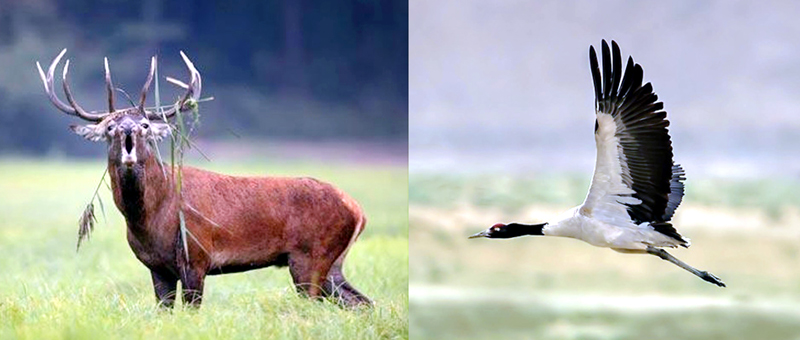Reorganisation creates distinctive task for administration
Mohinder Verma
JAMMU, Oct 6: In an interesting development relating to the bifurcation of the State, the administration of Union Territory of Jammu and Kashmir and Union Territory of Ladakh will have to search for new State bird and animal after October 31, 2019 when the new set-up will formally be in place.
Every State and Union Territory of India has a unique group of symbols like State animal and bird. These symbols have been chosen from unique flora and fauna and they depict a certain virtue that is distinctive characteristic of the State or Union Territory.
These symbols are often adopted after concerted efforts by the Governments to have a significant item recognized for its importance to the State or Union Territory. Moreover, these symbols represent the culture and the natural wonders unique to the particular State.
Jammu and Kashmir has Black-necked Crane as State bird and Kashmir Stag (Hangul) as State animal. Both these specifies are rarest of the rare as such were declared as official symbols long time back.
The bifurcation of the State, as per the provisions of Jammu and Kashmir State Reorganization Act, 2019, has created a task of its own kind for the administration—identification and declaration of new State bird and animal of Union Territory of Jammu and Kashmir and Union Territory of Ladakh.
Black-necked Crane, which is found only in Eastern Ladakh, can no longer be the State bird of Union Territory of Jammu and Kashmir while as Kashmir Stag (Hangul), which is found only in Valley, cannot be State animal of Union Territory of Ladakh.
Now, the administration will have to find out State bird of Union Territory of Jammu and Kashmir and State animal of Union Territory of Ladakh and EXCELSIOR has come to know that concerned Government agencies will set into motion an exercise in this regard after October 31, 2019 when the new UTs will be formally established.
“Recently, Advisor to Governor Vijay Kumar, who is incharge of Department of Wildlife, informally discussed the issue with the senior officers of the department and shortly a committee of officials will be set up to accomplish the task of its own kind”, sources said.
They disclosed that Black-necked Crane is the last of the world’s cranes to be discovered by the scientific community. In Ladakh, the Black-Necked Crane was first reported in 1919 by a naturalist at Tsokar during a bird collection trip. “Now, a highly vulnerable specie, the Black-necked Crane inhabits a region that is geographically inaccessible for much of the year”, sources added.
In India, Eastern Ladakh is the only known breeding ground of the Black-necked Crane outside of China. Owing to the special significances of the bird, it was declared as State bird of Jammu and Kashmir long time back. WWF-India in collaboration with the Department of Wildlife Protection has been working actively for the conservation of Black-necked Crane at various wetlands in Ladakh.
Kashmir Stag, popularly known as Hangul, is the only surviving sub-species of the Red Deer family. Once found in high altitude regions of Northern India and Pakistan, the Kashmir Stag is now confined to only Dachigam National Park in Kashmir. It has been considered as one of the rarest mammal in the subcontinent since 1950s.
The population of Hangul has decreased so low over a period of time that it has been classified as critically endangered by the International Union for Conservation of Nature’s Red Data Book.
The last king of Jammu and Kashmir Maharaja Hari Singh had constructed a rest house at lower Dachigam for sighting the Hangul and presently Hangul is restricted to Dachigam National Park near Srinagar.
“Since the State of J&K had rarest of the rare species as State bird and State animal, it would not be that easy for the administration to find out State bird for UT of J&K and State animal for UT of Ladakh”, sources said, adding “like new State bird and State animal for the UTs of J&K and Ladakh, the administration will have to also look for other symbols like State flower and State tree”.


